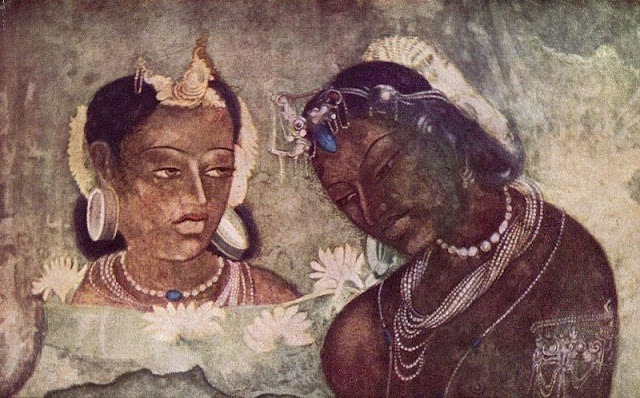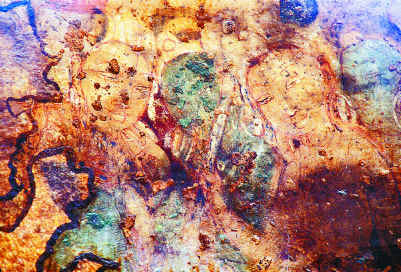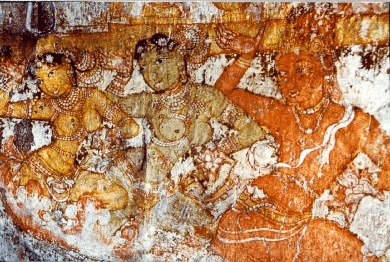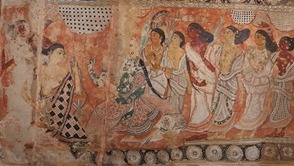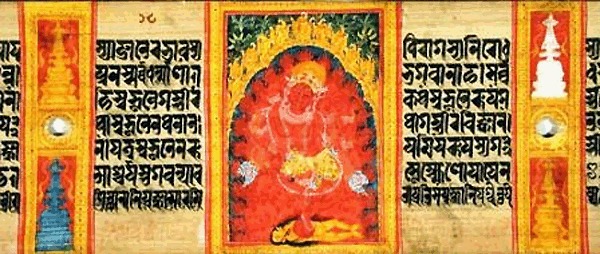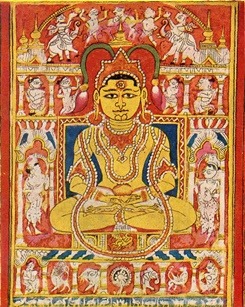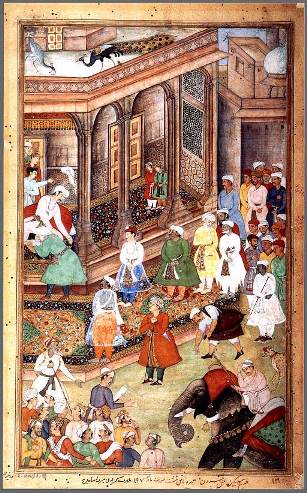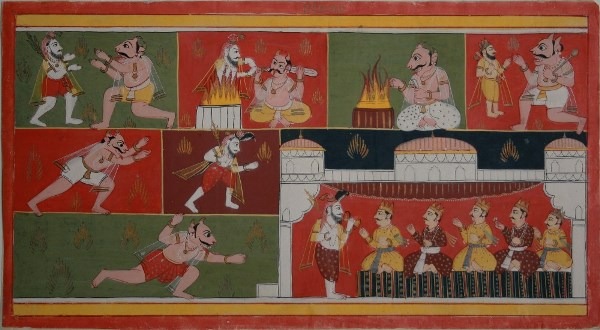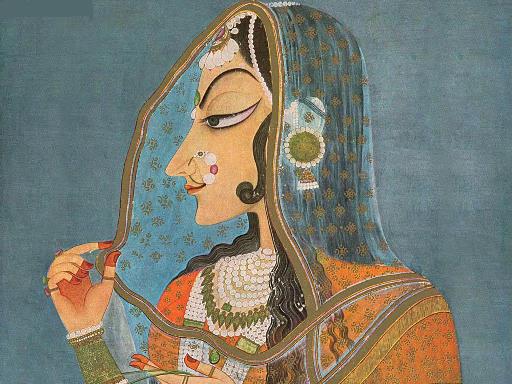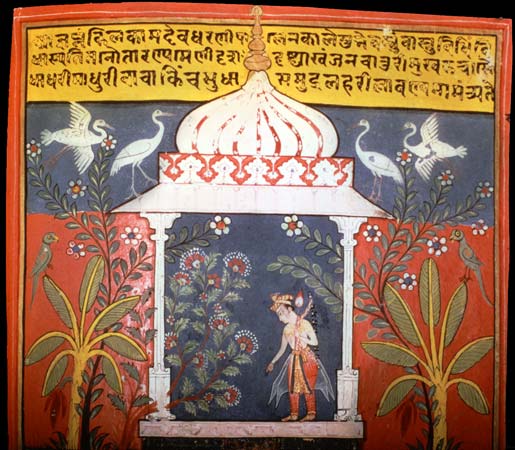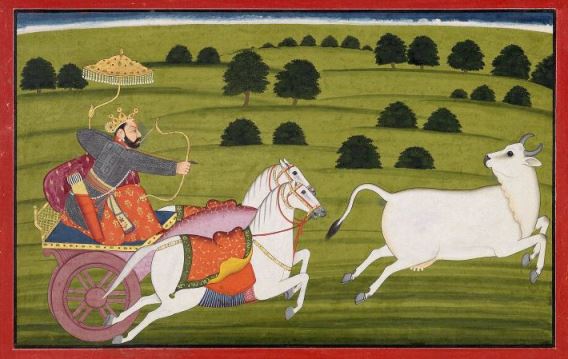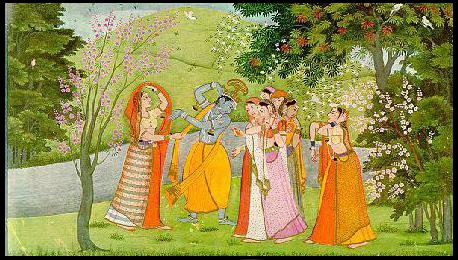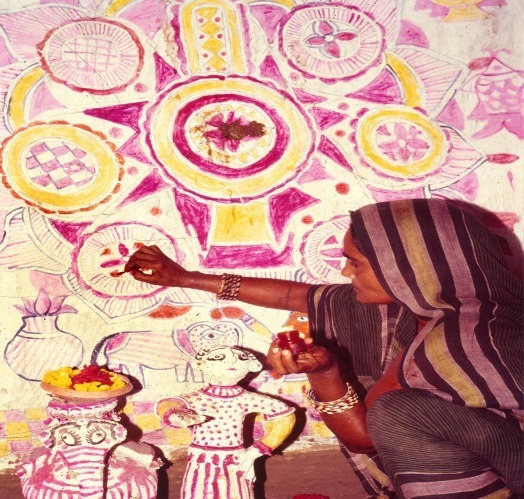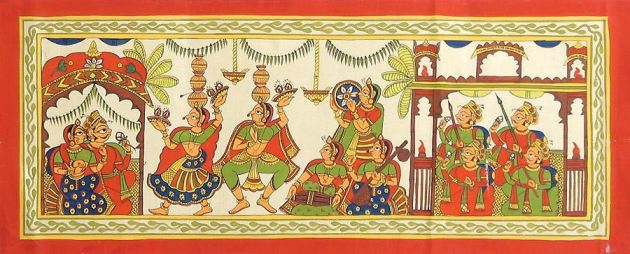Indian Paintings
Prehistoric Cave Paintings
- Painted rock shelters by prehistoric cave dwellers
- Notable example → Bhimbetka caves in the Kaimur Range, MP (biggest prehistoric art depositoryin India)
Genres of Indian Painting
- Indian paintings can be broadly classified as murals and miniatures.
- Murals are large works executed on the walls of solid structures directly, as in the Ajanta Caves & Kailash temple (Ellora)
- Miniature paintings are executed on a very small scale for books or albums on perishable material such as paper and cloth.
Mural Paintings
- Mural is the only form of painting that is truly three-dimensional, since it modifies and partakes of a given space.
- Mural paintings are applied on dry wall with the major use of egg, yolk, oil, etc.
- Notable examples → Ajanta Caves, Bagh Caves, Sittanavasal Caves, Armamalai Cave (Tamil Nadu), Kailasa temple (Ellora Caves)
- Murals from this period depict mainly religious themes of Buddhist, Jain and Hindu
Ajanta Murals Paintings
- Depict a large number of incidents from the life of the Buddha (Jataka Tales)
- Exclusively Buddhist, excepting decorative patterns on the ceilings and the pillars.
Ellora Murals Paintings
- Painted in rectangular panels with thick borders with following
- Prominent features → Sharp twist of the head + painted angular bents of the arms + sharp projected nose + long drawn open eyes + concave curve of the close limbs
Badami Mural Paintings
- A cave site in Karnataka, patronized by chalukya king, Manglesha
- Depictions in the caves show Vaishnava affiliation, Therefore, the cave is popularly known as Vishnu cave.
Murals under the Pallava, Pandava and Cholas
- Paintings at the Kanchipuram temple were patronised by Pallava king, Rajsimha
- Paintings at Tirumalaipuram caves & Jaina caves at Sittanvasal were patronised by Padayas
- Paintings at Nartamalai & Brihadeswara temple were patronized by Cholas
Vijayanagara murals (13th century)
- Paintings at Virupaksha temple (Hamphi) & Lepakshi temple (Andhra Pradesh) were patronised by Vijayanagara Kings
Miniature Paintings
- The Palas of Bengal were the pioneers of miniature painting in India.
- The art of miniature painting reached its glory during the Mughal period.
The Pala School (11th – 12th century)
- Exist in the form of illustrations to the religious texts on Buddhism executed under the Palas of the eastern India & the Jain texts executed in western India
- The Buddhist monasteries of Nalanda, Odantapuri, Vikramsila & Somarupa were great centers of Buddhist learning and art.
- A large number of manuscripts on palm-leaf relating to the Buddhist themes were written, illustrated with the images of Buddhist deities at these centers
- The Pala painting is characterized by sinuous line and subdued tones of colour
Western Indian School of Painting
- Also called Jaina Painting, largely devoted to the illustration of Jaina religious texts of the 12th–16th century
- Notable sites → Gujrat, Uttar Pradesh, Central India & Orissa
- Characterized by simple, bright colours, highly conventionalized figures, and wiry, angular drawing
Mughal Paintings (16th – 19th century)
- Mainly confined to miniature illustrations on the books or as single works to be kept in an album
- Mughal paintings were a unique blend of Indian, Persian (Safavi) and Islamic styles
- Marked by supple naturalism → Primarily aristocratic and secular
- Tried to paint the classical ragas and Seasons or baramasa
- Tuti-nama – first art work of the Mughal School.
- Akbar’s reign (1556–1605) ushered a new era in Indian miniature painting.
- At Zenith under Jahangir who himself was a famous painter
- Jahangir encouraged artists to paint portraits and durbar scenes.
- Shah Jahan (1627–1658) continued the patronage of painting.
- Aurangzeb had no taste for fine arts.
- Most significant are Hamza Nama, Razm-Nama or “The Book of War”, Akbar Nama
- Finest example of this school includes Hamzanama series, started in 1567 & completed in 1582
- Hamzanama → Stories of Amir Hamza, illustrated by Mir Sayyid Ali
- 1200 paintings on themes of Changeznama, Zafarnama & Ramayana
- The paintings of the Hamzanama are of large size, 20” x 27″ and were painted on cloth.
- They are in the Persian safavi style with dominating colours being red, blue and green
- Indian tones appear in later work, when Indian artists were employed
Rajput Painting (16th – 19th century)
- the art of the independent Hindu feudal states in India
- Unlike Mughal paintings which were contemporary in style, Rajput paintings were traditional & romantic
- Rajput painting is further divided into Rajasthani painting and Pahari painting (art of the Himalayan kingdoms)
Central Indian and Rajasthani Schools (17th – 19th Century)
- Deeply rooted in the Indian traditions, taking inspiration from Indian epics, Puranas, love poems & Indian folk-lore
- Mughal artists of inferior merit who were no longer required by the Mughal Emperors, migrated to Rajasthan
Malwa paintings (17th century)
- Centred largely in Malwa and Bundelkhand (MP); sometimes referred as Central Indian painting due to its geographical distribution.
- This school’s most appealing features is its primitive charm & a simple childlike vision
Kishangarh paintings (18th century)
- Distinguished by its individualistic facial type and its religious intensity
- Developed under the patronage of Raja Savant Singh (1748-1757 AD) by master artist Nihal Chand
Mewar (Udaipur) Paintings (17th – 18th century)
- Characterized by bold bright contrasting colours and direct emotional appeal
- The earliest-dated examples come from Ragmala (musical modes) series painted in 1605
- Reflects portraiture & life of the ruler, along with religious themes
Marwar (Jodhpur) Paintings
- Executed in a primitive and vigorous folk style
- Completely uninfluenced by the Mughal style.
- Portrays court scenes, series of Ragamala & Baramasa
Bundi paintings (Late 17th century)
- Very close to the Mewar style, but the former excels the latter in quality
- Prominent features → Rich and glowing colours, the rising sun in golden colour, crimson-red horizon, border in brilliant red colour (in Rasikpriya series)
- Notable examples → Bhairavi Ragini (Allahabad Museum), illustrated manuscript of the Bhagawata Purana (Kota Museum) & a series of the Rasikapriya (National Museum, Delhi)
Kota paintings (18th – 19th century)
- Very similar to Bundi style of paintings
- Themes of tiger and bear hunt were popular
- Most of the space in painting is occupied by the hilly jungle
The Pahari Schools (17th – 19th Century)
Comprises the present State of Himachal Pradesh, some adjoining areas of the Punjab, the area of Jammu, & Garhwal in Uttarakhand
Basohli Paintings (17th – 18th century)
- known for its bold vitality of colour, lines & red borders
- Emotional scenes from a text called “Rasamanjari” → Krishna legend
- Favoured oblong format, with the picture space usually delineated by architectural detail, which often breaks into the characteristic red borders
- Stylized facial type, shown in profile, is dominated by the large, intense eyes
Guler painting (Jammu)
- Mainly consisting of portraits of Raja Balwant Singh of Jasrota (Jammu) designed by Nainsukh
- Colours used are soft and cool unlike Basohli school
- Style appears to have been inspired by the naturalistic style of the Mughal painting
Kangra painting (Late 18th century)
- The Kangra style is developed out of the Guler style & possesses its main characteristics, like the delicacy of drawing & naturalism
- The Kangra style continued to flourish at various places namely Kangra, GuIer, Basohli, Chamba, Jammu, Nurpur and Garhwal etc.
- However, Named as Kangra style as they are identical in style to the portraits of Raja Sansar Chand of Kangra
- In these paintings, the faces of women in profile have the nose almost in line with the forehead, the eyes are long & narrow, & chin is sharp.
- There is, however, no modelling of figures and hair is treated as a flat mass.
- Paintings of the Kangra style are attributed mainly to the Nainsukh family.
Kullu – Mandi painting
- A folk style of painting in the Kulu-Mandi area, mainly inspired by the local tradition
- The style is marked by bold drawing and the use of dark and dull colours
Independent Paintings
Kalighat Paintings (Kolkata – 19th century)
- Patua painters from rural Bengal came and settled in Kalighat to make images of gods and goddesses in the early 19th century
- They evolved a quick method of painting on mill-made paper
- Used brush and ink from the lampblack
Madhubani Paintings (Mithila – Bihar)
- Colorful auspicious images on the interior walls of homes on the occasion of rituals & festivity → painted by women
- This ancient tradition, especially elaborated for marriages, continues today.
- Used to paint the walls of room, known as KOHBAR GHAR in which the newly wedded couple meets for the first time
- Very conceptual, first, the painter thinks & then “draws her thought”
Phad paintings (Bhilwada, Rajasthan)
- Phad is a painted scroll, which depicts stories of epic dimensions about local deities and legendary heroes.
- Bhopas (local priests) carry these scrolls on their shoulders from village to village for a performance
- Represents the moving shrine of the deity and is an object of worship
- Most popular & largest Phad – local deities Devnarayanji and Pabuji
Kalamkari Paintings (Andhra Pradesh)
- Literal meaning is painting done by kalam (pen) , Mainly in Andhra Pradesh (developed under Vijaynagar rulers)
- Stories from the epics Ramayana, Mahabharata and the Puranas are painted as continuous narratives
- Mainly to decorate temple interiors with painted cloth panels scene after scene; Every scene is surrounded by floral decorative patterns

Warli painting
- Practiced in tribal regions of Maharashtra with subjects, predominantly religious
- decorative paintings on floors & walls of ‘gond’ and ‘kol’ tribes homes and places of worship
- made in a geometric patterns like squares, triangles, and circles
- Unlike other tribal art forms, Warli paintings do not employ religious iconography and is a more secular art form.
Handicrafts
| Kashmir | Embroidered shawls, carpets, namdar silk and walnut wood furniture |
| Rajasthan | precious stone and jems + tie & dye (Bandhani) fabric + minakari work |
| Andhra Pradesh | Bidri work and Pochampad saris |
| Tamil Nadu | bronze sculpture and Kajeevaram silk saris |
| Mysore | silk, sandalwood items |
| Kerala | ivory carvings and rosewood furniture |
| Assam | cane furniture |
| Bengal | Bankura terracotta modelling and handloom items |
| Benaras | Brocade & silk saris |
| Madhya Pradesh | Chanderi and kosa silk |
| Lucknow | chikan work (Zardozi Embroidery – Muslims in Lucknow) |
| Punjab | Phulkari embroidery |
| Bengal | Kantha embroidery |
| Orissa | Patola embroidery |
| Budhhists | Thangka painting |
